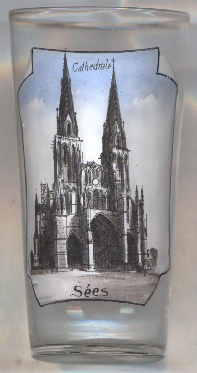

|
| FRANCE | FRANCE |
| région: Normandie | Normandy |
| département: 61, Orne |
Sées is a town in the department of Orne, on the Orne River 3 miles from its source and 13 miles north by northeast of Alençon. In 1999, its population was 4,501.
The traditional spelling of the town's name, which derives from the Latin Civita Sagiensis, capital city of the Celtic tribe Sagii, was Séez, and this spelling has been retained by the Church; the Diocese of Séez is headed by the Bishop of Séez. However, the spelling Sées was adopted for the town by the civil authorities following Napoléon's successful Italian campaign of 1796–1797, one result of which was to bring another (Savoyan) Séez into France.

 The first bishop of Sées was St. Lain (Latuinus; Latuin de Séez), who lived about the 4th century. In the 9th century, Sées was a fortified town and fell a prey to the Normans.
From 1356 the counts of Alençon were its possessors. It was captured and recaptured in the wars between Henry II of England and his sons. In the Hundred Years' War
it was one of the first towns of Normandy to fall into the hands of the English (1418). Pillaged by the Protestants during the Wars of Religion, Sées attached itself
to the Catholic League in 1589, but voluntarily surrendered to Henri IV of France in 1590.
The first bishop of Sées was St. Lain (Latuinus; Latuin de Séez), who lived about the 4th century. In the 9th century, Sées was a fortified town and fell a prey to the Normans.
From 1356 the counts of Alençon were its possessors. It was captured and recaptured in the wars between Henry II of England and his sons. In the Hundred Years' War
it was one of the first towns of Normandy to fall into the hands of the English (1418). Pillaged by the Protestants during the Wars of Religion, Sées attached itself
to the Catholic League in 1589, but voluntarily surrendered to Henri IV of France in 1590.
The  cathedral Notre Dame is remarkable for its architecture. The church dates from the 13th and 14th century and occupies the site of three
earlier churches. The west front, which is disfigured by the buttresses projecting beyond it, has two stately spires of open work 70 metres. high. The nave was built
towards the end of the 13th century. The choir, built soon afterwards, is remarkable for the lightness of its construction. In the choir are four bas-reliefs of great beauty
representing scenes in the life of the Virgin Mary, and the altar is adorned with another depicting the removal of the relics of St. Gervais and St. Protais.
The church has constantly been the object of restoration and reconstruction.
cathedral Notre Dame is remarkable for its architecture. The church dates from the 13th and 14th century and occupies the site of three
earlier churches. The west front, which is disfigured by the buttresses projecting beyond it, has two stately spires of open work 70 metres. high. The nave was built
towards the end of the 13th century. The choir, built soon afterwards, is remarkable for the lightness of its construction. In the choir are four bas-reliefs of great beauty
representing scenes in the life of the Virgin Mary, and the altar is adorned with another depicting the removal of the relics of St. Gervais and St. Protais.
The church has constantly been the object of restoration and reconstruction.
Glass no. 4874 [left and below] is marked on the bottom: Importé d'Autriche ('imported from Austria'). The picture on this glass is also interesting because it also depicts a scaffolding on the northern side of the cathedral. I have found an old postcard with an almost identical view [see below], which, although not posted, is dated 1916. Actually, restoration works on the vaulting of the nave were carried out at the beginning of the 20th century (c.1900–1910) and on the north tower of the cathedral in 1915.
[http://en.wikipedia.org/wiki/Sées;
https://en.wikipedia.org/wiki/S%C3%A9es_Cathedral, https://fr.wikipedia.org/wiki/Cath%C3%A9drale_Notre-Dame_de_S%C3%A9es]
![[scale]](lineal.jpg)